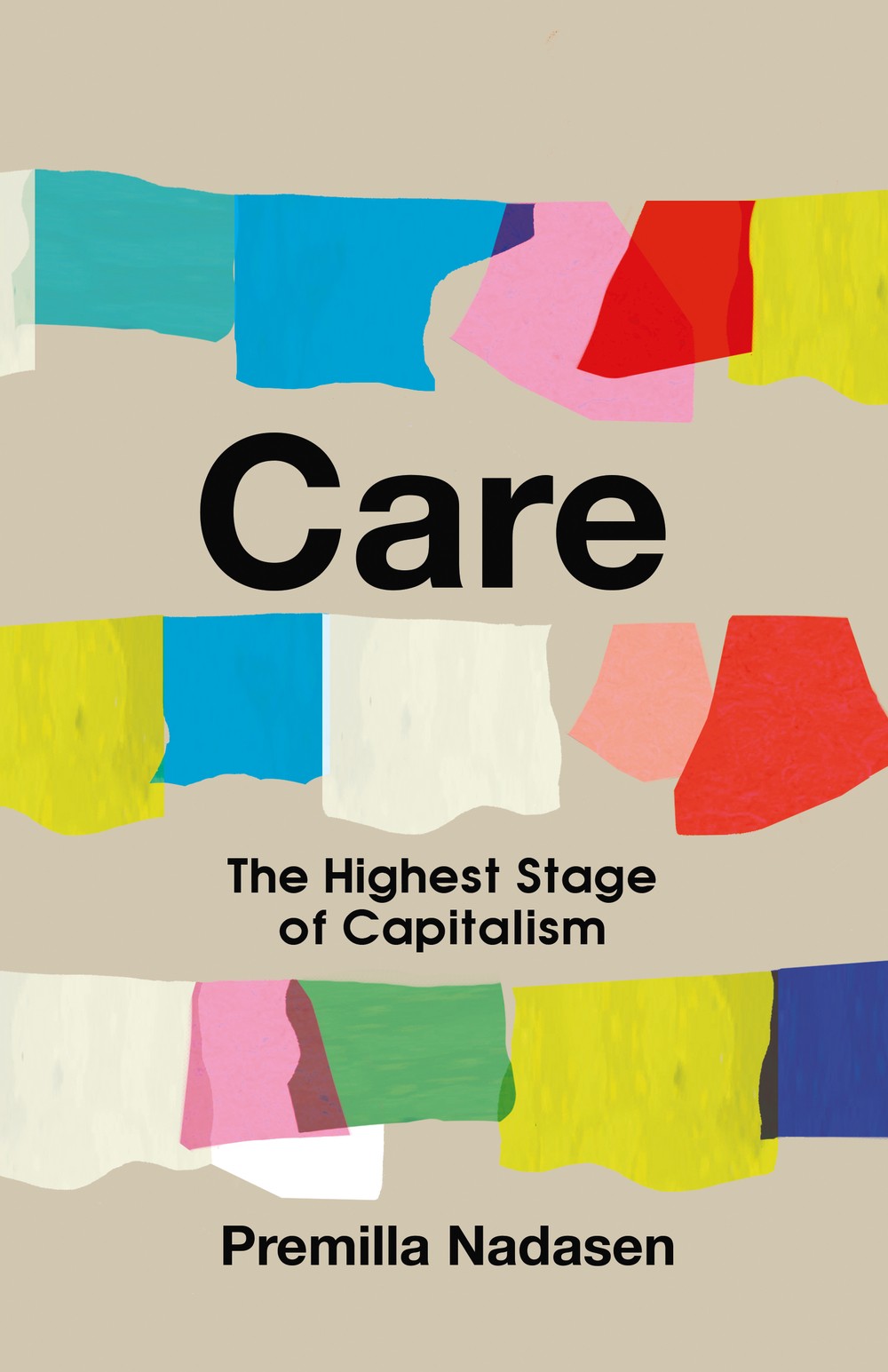
Premilla Nadasen
Care: The Highest Stage of Capitalism
Haymarket Books, 2023
273 pages
$19.95
Reviewed by Francesca Passaseo
From the ‘essential workers’ of the COVID-19 pandemic to the viral alleged killer of the UnitedHealthcare CEO, who performs care work and who has access to care has become a key concern in the US public consciousness. However, these recent developments show that although care is a necessary function of society, it is increasingly inaccessible for most Americans. Premilla Nadasen’s latest book, Care: The Highest Stage of Capitalism, makes a timely intervention in the dilemma of care and asks “why this dysfunctional care system continues to expand, despite the perpetual and recurring care crisis.” To understand this contradiction, Nadasen explores care work and the care economy through its discourse and institutionalization, demonstrating how state policies and labor practices have created an exploitative and inequitable hierarchy that excludes poor and working-class people from accessing the same care they provide on a paid and unpaid basis. From this perspective, the crisis is the culmination of centuries of policies and initiatives rooted in exploitation and racial capitalism, to which Nadasen proposes a ‘praxis of care,’ a racialized and gendered analysis that provides both a theoretical grounding and a framework for activism. Care focuses on how care became inequitable to the many and a source of profit to the few while advocating for the struggle and practice of ‘radical care,’ informed by the insights of radical Black and women of color organizers and feminists. Care argues the long-term solution to the care crisis is the abolition of racial capitalism, a proposition Nadasen extends to her readers by asking them to join her in imagining how “we can create a caring world as part of a radical future.”
As Nadasen explains in the first chapter, “Part of the Family: Gender, Labor, and the Care Work Discourse,” care work connotes a reciprocal emotional investment between the care recipient and the care worker. The first step in demystifying care is the rejection of the word itself. “Since the 1990s,” Nadasen states, “the term care work has been deployed on behalf of neoliberalism to detach the paid labor of social reproduction from the history of racial capitalism and capitalist labor and profit.” Care work “is structured along racial lines” and “falsely universalizes the experience of white women,” Nadasen argues, citing the work of Dorothy Roberts to demonstrate how the caring work typically done by white women has become the signifier of social reproduction.
In the second chapter, “What Is Social Reproduction and Why Should I Care?” Nadasen extends her critique of the discourse of care, arguing the association of care work with ‘women’s work’ led scholars to overstate gender as determining how social reproduction is understood. According to Social Reproduction Theory scholars Tithi Bhattacharya and Nancy Fraser, social reproduction is not a source but a precondition of capitalist profit. Nadasen critiques this position, reconceptualizing social reproduction through the lens of racial capitalism. Nadasen demonstrates that during slavery, capitalism benefited from labor power and life itself through the constant replenishment and surveillance of enslaved peoples. The consequences today include the precarity of people of color employed in low-paid social reproduction labor, the continued exploitation of immigrant and undocumented workers, and the rise of the prison-industrial complex. In addition, those excluded from the relations of capitalism (children, the elderly, and those with disabilities) became a source of profit through privatized care systems.
The third chapter, “Social Reproduction, Coercion, and Care,” Nadasen describes how US immigration policies encouraged the employment of foreign workers in paid social reproduction jobs, explaining that “the devaluation of paid domestic workers’ labor did not originate with familial ties and gender inequality in the home but rather with state power and racial inequality within the labor market.” Against this history of the systemic exploitation of racialized labor, Nadasen questions whether activists can trust the state to make a meaningful intervention against the care economy.
In the fourth chapter, “‘Tell ‘Dem Slavery Done’: Social Reproduction and the Politics of Resistance” Nadasen historicizes social reproduction activism. Rectifying the erasure of this tradition, Nadasen provides a feminist labor history, including various classes of workers (informal, service, and unpaid) and sites of economic struggle (including resources, housing, and welfare benefits.) The breadth of social reproduction mobilizations reflects the changing composition of the working class, presented as “a model of resistance applicable to a growing number of precarious workers in a neoliberal economy.” By studying groups such as the Household Technicians of America, the Chicago Teachers Union, the Wages for Housework campaign, and the National Welfare Rights Organization, activists and scholars can recoup novel forms of organizing that promote broad, cross-race alliances, mobilize in workplaces and public spaces, and fight for state protections and employer rights.
In the fifth chapter, “Who Cares? Caring (or Not Caring) for the Poor?” Nadasen contends with US policies, including the dismantling of the welfare state and the reduction in cash assistance have caused applicants to programs like SNAP and CHIP to be demonized and criminalized, not dissimilar to the racialized discourse of ‘welfare queens.’ In contrast, employer benefits and public assistance measures are freely available to the middle-class and the wealthy, typically direct hires, who benefit from a menu of support for their care needs, such as free childcare and medical insurance. Precariously employed groups, such as cleaners or cooks, are often excluded from such benefits, along with migrant and undocumented workers. Their exclusion defines who counts as a worker and, thus, who is worthy of care. The sixth chapter, “In Bed with Capitalism: The State, Capital, and Profiting off Those in Need,” addresses how politicians and for-profit companies exploit the care economy for personal wealth. By mapping the channels through which ‘care dollars’ are spent, such as medical debt and vaccine development during the COVID pandemic, Nadasen dispels the myth of austerity, contending that the plentiful funds of the care economy are stolen from the public and placed into the pockets of the private sector.
In her concluding chapter, “But Some of Us Are Brave: Radical Care and the Making of a New World,” Nadasen envisions radical care as a “care that is collective and anti-hierarchical, sits outside capitalist profit-making structures, and contributes to long-term social transformation.” Drawing on the legacy of Marxist groups like the Black Panther Party and the Young Lords Party, Nadasen demonstrates how radical care has historically helped communities “recognize that inadequate social reproduction services were a product of broader inequities.” Today, Black, Brown, and Indigenous activists continue this work, creating radical care initiatives in response to persistent failures of the state and the market economy.
From this perspective, Nadasen advocates an abolitionist framework as the only path toward reimagining care beyond capitalism. Care: The Highest Stage of Capitalism is a critical intervention in the political discourse on care and a call to arms for social transformation. Readers from across disciplines—including history, sociology, feminism, and social movement studies—as well as activists, can engage with this work to cast possibilities for care beyond capitalism. Ultimately, Nadasen’s work reveals that the current structure of care is less about care itself and more a mechanism of racialized and gendered capitalism, but one that can be resisted in pursuit of an equitable, truly caring society.

